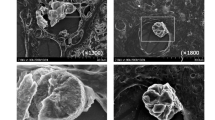Abstract
Most of kidney stones are supposed to originate from Randall’s plaque at the tip of the papilla or from papillary tubular plugs. Nevertheless, the frequency and the composition of crystalline plugs remain only partly described. The objective was to assess the frequency, the composition and the topography of papillary plugs in human kidneys. A total of 76 papillae from 25 kidneys removed for cancer and without stones were analysed by immunohistochemistry combined with Yasue staining, field emission-scanning electron microscopy and Fourier transformed infrared micro-spectroscopy. Papillary tubular plugs have been observed by Yasue staining in 23/25 patients (92%) and 52/76 papillae (68%). Most of these plugs were made of calcium phosphate, mainly carbonated apatite and amorphous calcium phosphate, and rarely octacalcium phosphate pentahydrate. Calcium and magnesium phosphate (whitlockite) have also been observed. Based upon immunostaining coupled to Yasue coloration, most of calcium phosphate plugs were located in the deepest part of the loop of Henle. Calcium oxalate monohydrate and dihydrate tubular plugs were less frequent and stood in collecting ducts. At last, we observed calcium phosphate plugs deforming and sometimes breaking adjacent collecting ducts. Papillary tubular plugging, which may be considered as a potential first step toward kidney stone formation, is a very frequent setting, even in kidneys of non-stone formers. The variety in their composition and the distal precipitation of calcium oxalate suggest that plugs may occur in various conditions of urine supersaturation. Plugs were sometimes associated with collecting duct deformation.






Similar content being viewed by others
References
Trinchieri A (2006) Epidemiological trends in urolithiasis: impact on our health care systems. Urol Res 34:151–156
Denstedt JD, Fuller A (2012) Epidemiology of stone disease in North America. In: Talati JJ, Tiselius H-G, Albala DM, YE Z (eds) Urolithiasis. Springer, London, pp 13–20
Hesse A, Brändle E, Wilbert D et al (2003) Study on the prevalence and incidence of urolithiasis in Germany comparing the years 1979 vs. 2000. Eur Urol 44:709–713
Ogawa Y (2012) Epidemiology of stone disease over a 40-year period in Japan. In: Talati JJ, Tiselius H-G, Albala DM, YE Z (eds) Urolithiasis. Springer, London, pp 89–96
Coe FL, Evan AP, Worcester EM et al (2010) Three pathways for human kidney stone formation. Urol Res 38:147–160
Randall A (1937) The origin and growth of renal calculi. Ann Surg 105:1009–1027
Evan AP, Lingeman JE, Coe FL et al (2003) Randall’s plaque of patients with nephrolithiasis begins in basement membranes of thin loop of Henle. J Clin Invest 111:607–616
Low RK, Stoller ML (1997) Endoscopic mapping of renal papillae for Randall’s plaques in patients with urinary stone disease. J Urol 158:2062–2064
Linnes MP, Krambeck AE, Cornell L et al (2013) Phenotypic characterization of kidney stone formers by endoscopic and histological quantification of intrarenal calcification. Kidney Int 84:818–825
Coe FL, Evan AP, Lingeman JE, Worcester EM (2010) Plaque and deposits in nine human stone diseases. Urol Res 38:239–247
Kuo RL, Lingeman JE, Evan AP et al (2003) Urine calcium and volume predict coverage of renal papilla by Randall’s plaque. Kidney Int 64:2150–2154
Evan AP, Lingeman J, Coe F et al (2007) Renal histopathology of stone-forming patients with distal renal tubular acidosis. Kidney Int 71:795–801
Verrier C, Bazin D, Huguet L et al (2016) Topography, composition and structure of incipient Randall plaque at the nanoscale level. J Urol 196:1566–1574
Khan SR (2004) Role of renal epithelial cells in the initiation of calcium oxalate stones. Nephron Exp Nephrol 98:e55–e60
Khan SR, Hackett RL (1991) Retention of calcium oxalate crystals in renal tubules. Scanning Microsc 5:707–711
Meria P, Hadjadj H, Jungers P et al (2010) Stone formation and pregnancy: pathophysiological insights gained from morphoconstitutional stone analysis. J Urol 183:1412–1416
Maurice-Estepa L, Levillain P et al (1999) Crystalline phase differentiation in urinary calcium phosphate and magnesium phosphate calculi. Scand J Urol Nephrol 33:99–305
Carpentier X, Daudon M, Traxer O et al (2009) Relationships between carbonation rate of carbapatite and morphologic characteristics of calcium phosphate stones and etiology. Urology 73:968–975
Daudon M, Bazin D (2016) Vibrational spectroscopies to investigate concretions and ectopic calcifications for medical diagnosis. C R Chimie 19:1416–1423
Evan AP, Lingeman JE, Worcester EM et al (2014) Contrasting histopathology and crystal deposits in kidneys of idiopathic stone formers who produce hydroxy apatite, brushite, or calcium oxalate stones. Anat Rec 297:731–748
Tournus M, Seguin N, Perthame B et al (2013) A model of calcium transport along the rat nephron. Am J Physiol Renal Nephrol 305:F979–F994
Khan SR, Glenton PA (2008) Calcium oxalate crystal deposition in kidneys of hypercalciuric mice with disrupted type IIa sodium–phosphate cotransporter. Am J Physiol Renal Physiol 294:F1109–F1115
Khan SR (2017) Histological aspects of the “fixed-particle” model of stone formation in animal studies. Urolithiasis 45:75–87
Author information
Authors and Affiliations
Corresponding author
Ethics declarations
Funding
This work has been supported by the Agence Nationale de la Recherche (ANR-13-JSV1-0010-01, ANR-12-BS08-0022), the Société de Néphrologie (Genzyme Grant), the Académie Nationale de Médecine (Nestlé-Waters award), Convergence-UPMC CVG1205 and CORDDIM-2013-COD130042.
Conflict of interest
All authors declare to have no conflict of interest.
Human and animal rights statement
All procedures performed in studies involving human participants were in accordance with the ethical standards of the institutional and/or national research committee and with the 1964 Helsinki declaration and its later amendments or comparable ethical standards.
Informed consent
Informed consent was obtained from all individual participants included in the study.
Rights and permissions
About this article
Cite this article
Huguet, L., Le Dudal, M., Livrozet, M. et al. High frequency and wide range of human kidney papillary crystalline plugs. Urolithiasis 46, 333–341 (2018). https://doi.org/10.1007/s00240-017-1031-9
Received:
Accepted:
Published:
Issue Date:
DOI: https://doi.org/10.1007/s00240-017-1031-9




